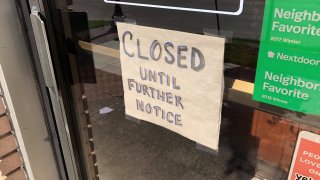
California’s coronavirus cases are surging and health officials say social gatherings and people not wearing masks or keeping their distance are fueling the rise. Yet it’s businesses that are paying the price in the form of revenue-sapping restrictions.
Business owners say that’s not fair and some medical experts say they have a point.
“It’s like you’re taking a sledgehammer to the problem; it’s not very fine-tuned,” said Dr. Peter Chin-Hong, a professor who specializes in infectious diseases at the University of California, San Francisco, of public health guidance. “It doesn’t address where a lot of the catalysts are for transmission.”
California crossed an unwelcome threshold on Thursday when the state's 1 millionth confirmed coronavirus case was logged. Average daily cases, infection rates and hospitalizations are surging.
State and local health officials for weeks have blamed the rising numbers on social gatherings — everything from backyard barbeques to Halloween festivities to victory celebrations for professional basketball's Lakers, baseball's Dodgers and, most recently, President-elect Joe Biden.
The rising numbers are leading to more closures under the state's four-tier system for reopening. It's based on each county's virus case and infection rates. Counties with lower rates have more freedom for businesses to operate, schools to open for classroom instruction and for formal gatherings like religious services.
When those rates rise, more limits are imposed and that's what's happening in much of California — by next week more than half the 58 counties will have moved to more restrictive tiers. Four of the state's five largest counties — Los Angeles, San Diego, San Bernardino and Riverside — are in the most restrictive tier.
California
News from across California
San Francisco has the lowest virus case rates among California’s major cities but still imposed new restrictions, banning indoor dining and cutting the capacity of gyms and movie theaters to 25%.
Danielle Rabkin, owner of CrossFit Golden Gate in San Francisco, said businesses are being unfairly targeted.
“They just see an uptick, and they shut things down without being more methodical about it,” said Rabkin, 39, whose rent for the gym is $14,000 per month and doesn't know how she'll pay all the back rent she owes.
“Where are these cases coming from? If it’s not from the businesses operating, don’t shut them down,” she said.
California's top health officials say the state's system is working as intended, with counties sliding forward and backward as infections warrant.
But critics question whether the system actually helps control the virus.
“One need look no further than Los Angeles County, where the dining rooms have been closed since March and yet you’re seeing these spikes,” said California Restaurant Association president and CEO Jot Condie.
California should trace coronavirus infections the way it does food poisoning: back to a specific restaurant or supply chain, said Dr. Jeffrey Klausner, a professor of epidemiology at the University of California, Los Angeles' Fielding School of Public Health.
"Without really knowing how much to implicate specific types of businesses and specific activities within those businesses, it’s not necessarily the most rational approach to just to uniformly close down a range of businesses,” Klausner said.
Chin-Hong said that in general, because health officials have less ability to control what goes on in private, they target the things they can control, like businesses or wearing masks in public.
Dr. Mark Ghaly, the state’s secretary of health and human services, said officials are painfully aware of the harm to businesses and plan to emphasize the plight of the local economy as they plead with pandemic-fatigued individuals to continue safe practices like wearing masks, washing hands and physically distancing.
“Collectively if we do those simple things and we do them well, that many of the businesses that are at risk of returning to lower levels of occupancy or closure may have a chance to stay open,” Ghaly said.
This week, researchers from Stanford and Northwestern universities touted the benefits of occupancy caps after they used cellphone tracking of 98 million people to report that most infections happened at “super-spreader” sites including restaurants and fitness centers, because patrons are close together for longer periods.
Several San Francisco Bay Area counties decided to follow the city of San Francisco and banned indoor dining even though their case levels allow them to keep them open under the state's rules.
Marin County’s health officer, Dr. Matt Willis, said restaurants have been the source of super-spreader events because families tend to linger and they can’t keep masks on while eating.
But not even all public health officials in the Bay Area see things similarly. Solano County public health officer Dr. Bela Matyas said the vast majority of cases have been traced back to casual gatherings.
“We’ve had no clusters we can attribute to restaurants, to gyms, to retail shopping, to any of those facilities,” Matyas said. “Because they have licensure on the line, they do a good job of enforcing social distancing.”
In San Diego County, the state’s second-most-populous, owners of four restaurants and gyms filed a lawsuit Thursday seeking an emergency injunction that would halt the order that they move their operations outdoors because the county’s virus numbers have moved them into the most restrictive tier.
Sacramento County Health Services Director Dr. Peter Beilenson agrees that restaurants and gyms are not at fault and told Capital Public Radio that he wants state officials “to be a little more judicious and surgical on how they made their decisions.”
Associations representing downtown Sacramento businesses sent Ghaly a letter making the same case. His office did not respond to questions about whether the state is reconsidering its guidelines.
Business organizations say it's healthier to keep the economy open, crack down on bad actors and reward entrepreneurs who invest in equipment to reduce aerosols and droplets in the air that can spread the coronavirus.
This is the third time Planet Fitness area director Layna Luchte will have to furlough some 150 employees at eight Sacramento County gyms that were forced to stop operating at 10% indoor capacity.
“There's been nothing that says gyms are the problem,” she said. “We just want to know what can we do to stay open.”
John’s Grill, a celebrated seafood and steak restaurant in downtown San Francisco, previously survived the 1918 flu epidemic, owner John Konstin Jr. noted as he prepared an outdoor space with heat lamps, roof and plexiglass.
He said he feels for fellow owners but plans to persevere.
“We’ve been through two pandemics in one lifetime of a restaurant. We plan to push through this one," he said.



